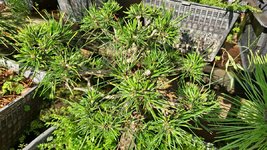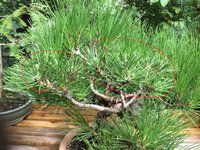WNC Bonsai
Omono
This coming spring I plan to repot my small shohin size JBP. It has been in a pond basket since before I got it a couple of years ago and I have no idea what the roots look like and since the basket is starting to crack apart it needs a new pot. So I assume the best time to repot is just as the buds start to swell and new root growth is beginning. Given the disturbance of repotting I also plan to skip decandling this year to give it time to recover, plus it has been decandled for at least the past two years that I have owned it.
So here is the real question. If I skip decandling this year then I expect those that pop this year will extend quite a bit so I will have a bunch of longer branch ends on top of my more compact and ramified tips. So in subsequent years what is the best strategy for getting it back into a more compact package? I am hoping that by letting the candles extend this year I will get more back budding and can simply prune back the extended growth from this coming year. Is that the best strategy for recovery after skipping a year?
So here is the real question. If I skip decandling this year then I expect those that pop this year will extend quite a bit so I will have a bunch of longer branch ends on top of my more compact and ramified tips. So in subsequent years what is the best strategy for getting it back into a more compact package? I am hoping that by letting the candles extend this year I will get more back budding and can simply prune back the extended growth from this coming year. Is that the best strategy for recovery after skipping a year?



